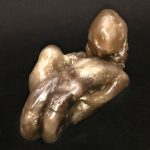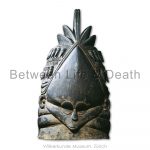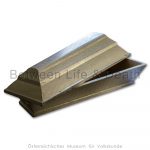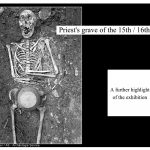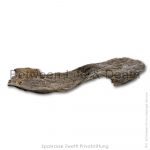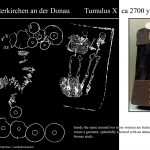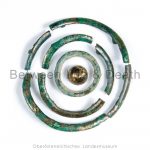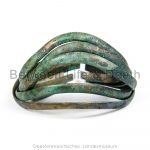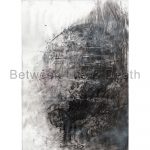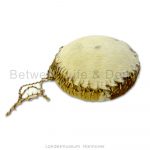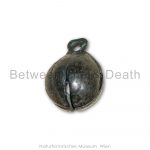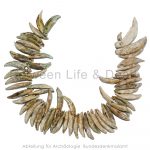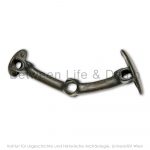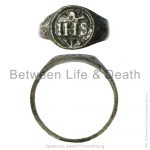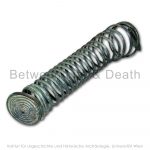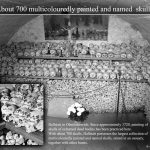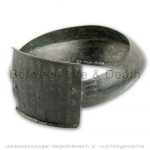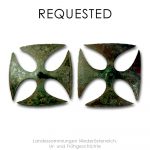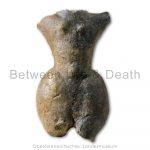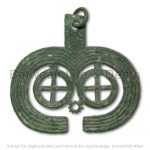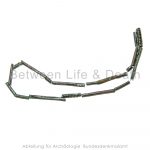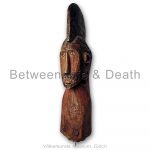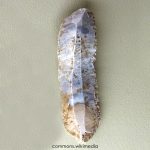Death separates – The fear of it and mourning rites and rituals, unite.
Cycle of Life and Death
Man is a tiny part of the cosmic and universal cycle of becoming and passing. With birth, the end, or death, is also already established. Man must live with this incomprehensible reality. The cycle of becoming and passing is digitally visualized through a display of current worldwide birth and death rates, of at least two births to one death per second. This flowing into one another of the beginning and the end of life is represented by an artwork. It exchanges the role of two figures, a baby and an old/dying person, turning into one another, against a background of a ’supernova‘ which simultaneously symbolizes the end and the beginning.
Object: Artwork by B. Eigner: two figures, a baby and an old/dying person, turning into one another.
Design: ʻLifeʼ and ʻDeathʼ are woven into one another in a sculpture, against a background of a ʻsupernovaʼ , which simultaneously symbolizes the end and the beginning.
Media: A sound composition is embedded into the eternal cycle of becoming and passing. It refers to the rhythm that is simulated by the current birth and death rates, digitally visualized through a display.
___ Cycle of Life and Death
Inevitability of the death
Each time its own death – our way of dealing with the inevitable reality of death is culturally informed. The omnipresent death of the Middle Ages formed almost a natural part of life. Today, in our modern industrial society, the dying and mourning experiences are concealed form the community.
Objects: Art, folk art (like face-mask), folk belief (like ‚Tödlein‘ (‚Little Death‘)), archaeology (grave goods), and a play (like ‚Jedermann‘)
Design: A room sculpture, consisting of lamellae forming a body which flows into itself, bears the various images of death.
Media: Video displaying parts of ‚Jedermann‘, a play by H.v. Hofmannsthal.
___ Inevitability of the death
Processes of farewell – ‚Spiral-like backbone‘
Spiral segments indicate the different subject areas and lead the visitors along the various farewell processes. These spiral segments are accompanied by grave goods of expressive archaeological funerals and relics of rites of farewell.
Objects: Archaeology, medical history, art, folk art, ethnography.
Design: The topics are being artistically and atmospherically visualized on the ʻopenedʼ panels by means of large-format, backlit graphics.
Media: Illustrations, Video (?).
___ Processes of farewell
Art
Free-standing design elements present art connected to death: modern art, folklore, folk believe, and ethnographic objects.
Objects: Modern art, folklore, folk believe, ethnography.
Design: Free-standing design element with show cases presenting art objects.
Media: Video (?)
___ Art
‚Farewell element‘
‚Farewell elements‘ carry the two levels of life and death: the funeral and a conception of the beyond. Myths and stories connect the fascinating objects, presented in the show cases, with a possible or abstract conception of the beyond.
Objects: Archaeology, ethnography, folk art.
Design: By means of large back-lit graphics, a drawn interpretative depiction of a funeral is shown on the lower half, whereas the upper level shows a possible or abstract conception of the beyond. A show case, placed beside, presents archaeological grave goods, ethnographic or folk art objects in a subtle and discrete atmosphere.
Media: Illustration.
___ 'Farewell element'
Funerals from the Stone Age until today
At this exhibition element interesting funerals and grave situations are visualized and animated, accompanied by amazing grave goods. The visitor undertakes a journey around the world, to some of the most exciting and touching funerals from the Stone Age until today.
Objects: Extraordinary burial objects.
Design: An elongated showcase with extraordinary burial objects lies below a curved element with two touch screens at their ends.
Media: Touch screen.
___ Touchscreen - Funerals from the Stone Age until today
A Journey around the world
Inhumation, cremation burial, mummification, sky burial, water burial: burial customs, partly still practiced worldwide, broaden our picture of the diversity of customs related to death and burial. At this exhibition element, the visitor encounters, by means of fascinating objects, pictures and videos, humankind worldwide in its dealings with death and mourning. A touch screen demonstrates and informs about the farthest cemeteries and burial customs around the world and recapitulates with a question-response game.
Objects: Ethnography.
Design: The great diversity of different mourning rites worldwide, are shown on square boards by means of images and videos. Original objects of the rites and cultures being presented, are exhibited in the corresponding showcases below.
Media: Video, touch screen, question-response game.
___ A Journey around the world
Religions and the soul
Rites for the dead are tightly connected to the ‚religious‘ background of a community. The religions offer rituals with fixed processes and rules, each in its particular way. They should give the bereaved persons consolation, stability and support. An ‚overview‘ of the world religions puts humans and their souls in the centre.
Object: Sculpture: Artwork by O. Pfeiler and B. Eigner.
Design: A sculpture with the working title ’soul‘ stands in the centre of this installation. Surfaces represent the religions, which, through guides, tell of their respective farewell-rite processes.
Media: Interactive: Hands on.
___ Religions and the soul
A time journey
Archaeology knows a variety of grave-types and funeral customs. The graves are the visualization of mourning and consolation for the ones left behind. The best known funeral types from the Stone Age until the Modern Era, are cremation and inhumation, with many disposal options.
Objects: Archaeological grave goods.
Design: A seven metre long illustration shows some of the most contrasting funerary rituals of the last 7000 years, as if they were all part of a single funeral ceremony. In one lavish, continuous showcase, below the ‚ceremonies‘, representative sensational objects of each period, or, respective funeral type, are displayed.
Media: Illustration.
___ A time journey
Eternal?
The desire for eternal youth, and beliefs in an afterlife, are old. The commemorative culture enables the continued social life of a person in a community. Statues, paintings, photographs, and death masks preserve the memory of the role of the deceased person. Some people today even choose to have a memorial diamond made from the bones of their lost loved ones to carry on their finger.
Objects: Art, theatre, folklore, memorabilia.
Design: By means of large back-lit graphics, a drawn interpretative depiction of a funeral is shown on the lower half, whereas the upper level shows a possible or abstract conception of the beyond. A show case, placed beside, presents death masks and other memorabilia below a video wall, the „commemorative culture“ of today.
Media: Interactive video wall with internet access.
___ Eternal?

